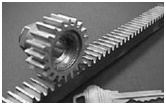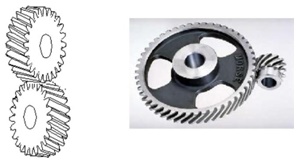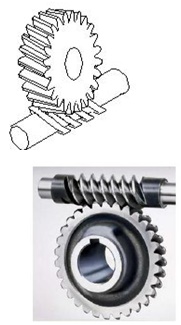Chapter: Mechanical : Kinematics of Machinery : Gears and Trains
Gear Classification
Gear Classification: Gears may
be classified according to the relative position of the axes of revolution. The axes may be
1.
Gears for connecting parallel shafts,
2.
Gears for connecting intersecting shafts,
3.
Gears for neither parallel nor intersecting shafts.
Gears for connecting parallel
shafts
1. Spur gears: Spur gears are the most common
type of gears. They have straight teeth, and are mounted on parallel shafts. Sometimes, many spur gears are
used at once to create very large gear reductions. Each time a gear tooth
engages a tooth on the other gear, the teeth collide, and this impact makes a
noise. It also increases the stress on the gear teeth. To reduce the noise and
stress in the gears, most of the gears in your car are helical.

Spur
gears are the most commonly used gear type. They are characterized by teeth,
which are perpendicular to the face of the gear. Spur gears are most
commonly available, and are generally the least expensive.
·
Limitations:
Spur
gears generally cannot be used when a direction change between the two shafts is required.
·
Advantages:
Spur
gears are easy to find, inexpensive, and efficient.
2. Parallel helical gears: The teeth
on helical gears are cut at an angle to the face of the gear. When two teeth on a helical gear
system engage, the contact starts at one end of the tooth and gradually spreads
as the gears rotate, until the two teeth are in full engagement.

This
gradual engagement makes helical gears operate much more smoothly and quietly
than spur gears. For this reason, helical gears are used in almost all car
transmission.
Because of the angle of the
teeth on helical gears, they create a thrust load on the gear when they mesh.
Devices that use helical gears have bearings that can support this thrust load.

One
interesting thing about helical gears is that if the angles of the gear teeth
are correct, they can be mounted on perpendicular shafts, adjusting the
rotation angle by 90 degrees.
Helical
gears to have the following differences from spur gears of the same size:
o Tooth
strength is greater because the teeth are longer,
o
Greater surface contact on the teeth allows a
helical gear to carry more load than a spur gear
o
The longer surface of contact reduces the
efficiency of a helical gear relative to a spur gear

Rack and pinion (The rack is
like a gear whose axis is at infinity.): Racks are straight gears that are used
to convert rotational motion to translational motion by means of a gear mesh.
(They are in theory a gear with an infinite pitch diameter). In theory, the
torque and angular velocity of the pinion gear are related to the Force and the
velocity of the rack by the radius of the pinion gear, as is shown.
Perhaps the most well-known
application of a rack is the rack and pinion steering system used on many cars
in the past
Gears for connecting intersecting
shafts: Bevel gears are useful when the direction of a shaft's rotation needs to be changed.
They are usually mounted on shafts that are 90 degrees apart, but can be
designed to work at other angles as well.
The teeth
on bevel gears can be straight, spiral or hypoid. Straight bevel gear teeth
actually have the same problem as straight spur gear teeth, as each tooth
engages; it impacts the corresponding tooth all at once.
Just like
with spur gears, the solution to this problem is to curve the gear teeth. These
spiral teeth engage just like helical teeth: the contact starts at one end of
the gear and progressively spreads across the whole tooth.

On straight and spiral bevel
gears, the shafts must be perpendicular to each other, but they must also be in
the same plane. The hypoid gear, can engage with the axes in different planes.
This feature is used in many car differentials. The ring gear of the
differential and the input pinion gear are both hypoid. This allows the input
pinion to be mounted lower than the axis of the ring gear.
Figure shows the input pinion
engaging the ring gear of the differential. Since the driveshaft of the car is
connected to the input pinion, this also lowers the driveshaft. This means that
the driveshaft doesn't pass into the passenger compartment of the car as much,
making more room for people and cargo.
Neither parallel nor intersecting shafts: Helical gears may be used to
mesh two shafts that are not parallel, although they are still primarily use in
parallel shaft applications. A special application in which helical gears are
used is a crossed gear mesh, in which the two shafts are perpendicular to each
other.

Worm and
worm gear: Worm gears are used when large
gear
reductions are needed. It is common for worm gears to have reductions
of 20:1, and even up to 300:1 or greater.
Many worm
gears have an interesting property that no other gear set has: the worm can
easily turn the gear, but the gear cannot turn the worm. This is because the
angle on the worm is so shallow that when the gear tries to spin it, the
friction between the gear and the worm holds the worm in place.
This
feature is useful for machines such as conveyor systems, in which the locking
feature can act as a brake for the conveyor when the motor is not turning. One
other very interesting usage of worm gears is in the Torsen differential, which
is used on some high-performance cars and trucks

Related Topics